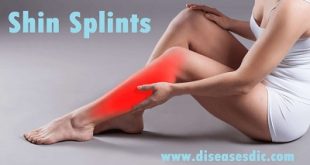Definition
Bunions are the bony bump that is enlarged in the joints at the base of the big toe. This enlargement is due to the misalignment of the bone joint and it leads to the stretching of tendons and ligaments which is present around the big toe joints. This caused the soft tissue around the joint to inflamed (bursitis) and causes pain, redness, and tenderness. There may be some additional fluid-filled sacs which form adjacent to the joints and thus leads to additional swelling, redness, and pain. Over the time joints may break down and lead to localized arthritis.
Bunion
Pathophysiology
- The bump itself is due to the swollen bursal or the protruded bone on the metatarsophalangeal joint. The large part of the bump is the normal part of the metatarsal bone, that tilted in the side to stick out at the distal end.
- The bunions are mainly due to the deviated position of the big toe towards the second toe and the difference in the angle between the first and second metatarsal bone of the toe. Over the time the small bones beneath the first metatarsal deviate and drift apart from its normal position.
- Osteoarthritis of the first metatarsophalangeal joint, diminished and/or altered range of motion, and discomfort with pressure applied to the bump or with the motion of the joint may all accompany bunion development.
- Atop of the first metatarsal head either medially or dorsomedially, there can also arise a bursa that when inflamed (bursitis), can be the most painful aspect of the process.
Anatomy of normal and bunion bone
Epidemiology of Bunions
- In the United States, the number of forefoot operations for the three most common forefoot ailments (HV, hammertoe, and intermetatarsal perineural fibrosis) is markedly higher in females than in males.
- The prevalence of HV is markedly higher in females, with studies reporting a female-to-male ratio of 8-9:1 and even as high as 15:1. This discrepancy is attributed to differences in footwear.
- With regard to age, the peak onset of HV is from age 30-60 years, though it is likely that the initial changes occur during adolescence or even earlier in the case of juvenile HV.
Types
The types of bunions vary based on the angle between the bones includes:
Mild structural bunions: The angle between the first and second long bones increases to a point where it is greater than normal. This increased angle may cause pain and cause the great toe to the second toe. This bump may become red and sore based on your footwear.
Severe structural bunions: In this type of bunions the angle between the first and second metatarsals bones is large. This needs surgery, to remove the wedge of bone in order to reposition the first metatarsal bone closer to the second.
The Hallux Osteotomy: The great toe angles inward toward the other toes, a painful callus can occur Depending on whether the great toe abuts, underrides or overrides the second toe, various problems can occur. These include hammertoe formation of the second toe and painful corns. To make the bunion bone as normal structure surgery can be done by removing the edge of the bone. Once this is performed, the bone is secured with some kind of fixation device, such as tiny wires.
Risk factors
Some of the risk factors that cause the bunions are as follows:
- Arthritis: people who have arthritis also cause the risk of developing bunions. They may face some changes in their movement which is caused by their pain of this disease.
- Hereditary: If you have inherited structural foot defect, then you have increased risk getting the bunion.
- High heels: Women’s who wearing high heels forces your toes into the form of your shoes and in many cases, it collapses the toes.
- Fitting shoes: Too tight fitting shoes may also the risk of getting bunions by narrowing the points of the joints.
Causes of Bunions
Causes of bursitis are not known. But it seems to be inherited genetic factors may also cause bunion especially when overpronation can predispose to the development of bunions. Bunions mostly occur in younger individuals. Some of the factors likely include such as:
- The unbalanced biomechanics can also cause the joints instability and deformity
- Wearing improper fitting shoes mainly high heels which have narrow pointed toe box that forces the toes into unnatural position
- Inflammatory conditions such as rheumatoid arthritis, or a neuromuscular condition such as polio
- The previous injury may also cause bunions
- Nerve condition also cause bunions
Mostly bunions commonly affect the women’s (approximately 90% of cases).
Symptoms
- Frequent pain when walking and wearing shoes.
- Intermittent pain when wearing a tight shoe.
- Bulging bump on the edge of the toe.
- Redness and swelling of the toe.
- Numbness.
- Difficulty in moving the toe.
- Development of corns and calluses often occur when the first and second toe overlaps.
- Unable to move the toe if bunions develop into arthritis.
- Over time it becomes shiny and warm when you touch.
- Big toe headed in the opposite direction.
- In severe cases, big toe overlaps above or below the second toe.
- Skin thickness on the basement side of the affected toe.
Complications of bunions
- Usually, Bunion starts very mild and grows abnormally over time if not treated.
- Unable to walk frequently and speedy.
- Metatarsalgia, an inflammation of the ball of the foot
- Hammertoe, an abnormal bend in the joint of the toe
- The muscle near the toe joint gets inflamed.
- Bursitis
Diagnosis and Test
In most cases, a doctor can visualize the inflammation and swell through open eyes. But to visualize the structural orientation of the big toe imaging techniques can be used.
- X-ray: If a doctor suspects an injury and deformation in the big toes, he or she may order you for X-ray. Using an X-ray image, the deformities in the bone can be identified.
- Blood test: Bunion disease may also arrive due to arthritis. Hence blood test is required to rule out arthritis as a cause.
Treatment and Medications
- Use of Wide toed footwear May reduce your pain and relieve the pressure on the toe.
- Use of bunion splints, toe pads, and bunion pads may relieve the adequate pain.
Bunion Splint
Bunion pads
- Avoiding activities such as sports, dancing and practicing physical exercises.
- Avoid standing for the too long period since it may progress to the vigorous stage.
- Use padded shoes and other orthotic devices while walking on the floor.
- Apply warm soak and ice packs on the affected toe when it is painful and irritating. Applying ice packs will reduce the swelling.
- Take non-steroidal anti-inflammatory drugs such as ibuprofen and naproxen to reduce the inflammation around the toe.
- Injection like cortisone. These can also relieve swelling, particularly in the fluid-filled pads that cushion the bones.
Surgery: Surgery is used for the people whose pain and inflammation is not getting healed properly even after following the above treatment measures. When a person needs bunion surgery, a doctor can choose several types of bunion surgery as follows.
Repair of ligaments and tendons: This involves the shortening and repairing of the weak tendons and ligaments. These procedures often perform along with the osteotomy.
Osteotomy: This is the procedure to cut down the unwanted bone for the alignment of the disoriented bones.
Arthrodesis: It is also known as ankylosis. It is the procedure which involves the artificial induction of the joint ossification between the bones by means of surgery.
Exostectomy: It is the surgical excision of bumpy bones from the toe.
Resection arthroplasty: Removing the damaged bones and tissues to provide space for the toe bone. This procedure is performed only for the persons who have;
- Older age
- Unsuccessful bunion surgery in the previous attempt.
- A patient with severe arthritis who cannot undergo arthrodesis surgery.
Prevention of bunions
- Use Proper-fitting footwear and orthotics
- Avoid narrow shoes
- Don’t wear high heels
- Walk around the house in bare feet. Instead of using appropriate shoes, walk around the home with bare feet.
- Maintain a healthy weight.
 Diseases Treatments Dictionary This is complete solution to read all diseases treatments Which covers Prevention, Causes, Symptoms, Medical Terms, Drugs, Prescription, Natural Remedies with cures and Treatments. Most of the common diseases were listed in names, split with categories.
Diseases Treatments Dictionary This is complete solution to read all diseases treatments Which covers Prevention, Causes, Symptoms, Medical Terms, Drugs, Prescription, Natural Remedies with cures and Treatments. Most of the common diseases were listed in names, split with categories.








I hit my toe very hard on a hard object… my toe dislocated and like the in this picture, please is my situation also this disease?
It might be due to the force applied to your toe. But please consult with a doctor because this damage may progress to bunions toe.
I used to see this bunion thing thinking it ‘s normal to have bent big toe. can this be treated and it stops forever from family inheritance
yet it can be treated.
its bunion treatment is that,to wear closed shoes for a long time.
Tight shoes worsen the bunion. It is advised to wear bunion splints and bunion pad.
I I am diabetic and I need to get my bunion fixed can you help me or tell me what to do
please consult a doctor to get rid of this problem.
Thanks, for that information about bunion.My right leg big toe has a mild bunion that sometimes is painful and that information will help me to take care of my feet.
after the bunionectomy will the toe continue to function like before??
Yes definitely if you practiced regular physiotherapy then it would be possible to be as normal.
My problem is that my two legs use to be hot when relaxing
please consult a doctor.
good information
I wish to do bunionectomy in both foot can I Succceed?
Please consult a doctor before proceeding to the surgery.
what should I do because I really feel pain at my toes
Kindly check your shoe model whether it’s creating pain in toes.